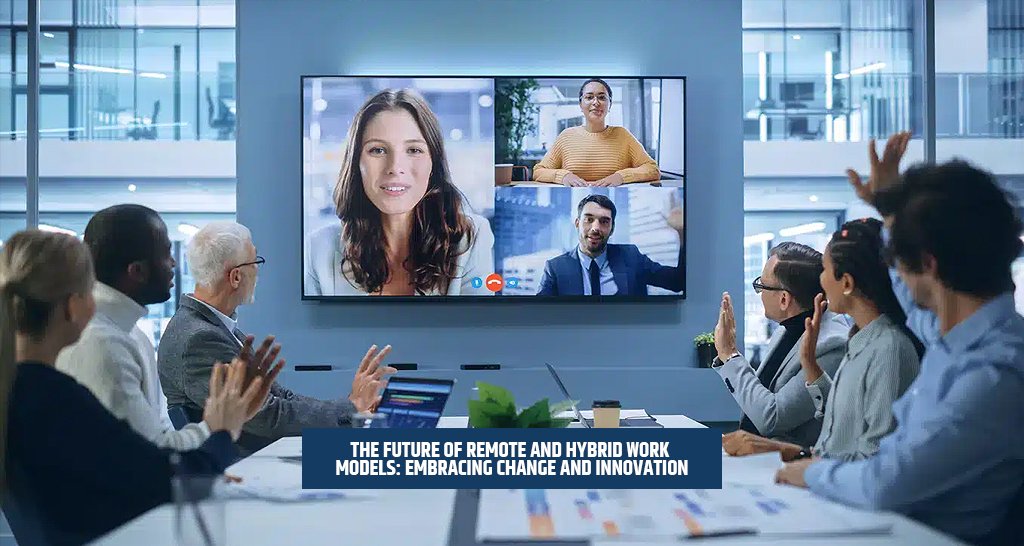Introduction to Remote and Hybrid Work
Remote and hybrid work models have transformed the traditional landscape of employment, representing a paradigm shift in how organizations operate and how employees interact with their workplaces. At their core, remote work refers to employees performing their job duties from locations outside of the conventional office environment, leveraging technology to stay connected with their teams. In contrast, hybrid work combines elements of both remote and in-person work, allowing employees to alternate between working remotely and physically attending the workplace. This flexible approach caters to diverse work styles and personal preferences, making it increasingly popular among modern professionals.
The significance of remote and hybrid work models cannot be overstated, particularly in light of recent global trends. The onset of the COVID-19 pandemic accelerated the adoption of these work arrangements, compelling organizations to rethink their operations almost overnight. This paradigm shift was driven not only by necessity but also by the technological advancements that facilitated seamless communication and collaboration across distances. Tools such as video conferencing, project management software, and cloud-based applications have empowered teams to work effectively from various locations, thereby drastically altering the conventional office setup.
Furthermore, changes in employee expectations have played a crucial role in the rise of remote and hybrid models. As the workforce evolves, many employees express a preference for flexible working conditions that promote work-life balance. The ability to tailor working hours and environments has become increasingly desirable, leading employers to explore these models as viable alternatives to traditional employment frameworks. Additionally, research indicates that remote work can enhance productivity and employee satisfaction, further solidifying its importance in the modern work environment. Consequently, understanding the foundations of remote and hybrid work is essential for organizations seeking to adapt to this new reality.
Advantages of Remote and Hybrid Work
The shift towards remote and hybrid work models has garnered considerable attention, and it brings a multitude of advantages for both employees and employers. One of the most significant benefits is the increased flexibility that these arrangements offer. Employees can tailor their work schedules to better align with personal responsibilities and preferences, leading to a more productive working environment.
Moreover, remote work often improves work-life balance. Many employees find that the elimination of a daily commute not only saves time but also reduces stress, allowing them to focus more on their professional tasks and personal commitments. This balance is crucial as it can lead to enhanced job satisfaction, which is a pivotal factor in employee retention rates for an organization.
Additionally, remote and hybrid work models enable companies to tap into a broader talent pool. Geographical limitations are no longer barriers, allowing organizations to recruit the most qualified candidates regardless of their physical location. This access to diverse skill sets can foster innovation and creativity within teams, which can, in turn, enhance overall company performance.
Cost savings also represent a major advantage for businesses that adopt these work models. Remote work can lead to reduced overhead expenses related to office space, utilities, and supplies, enabling organizations to redirect savings to other strategic initiatives. Furthermore, with a hybrid approach, companies can optimize their physical office usage by scaling down on real estate requirements while still accommodating essential in-person collaboration.
In light of these benefits, it is evident that remote and hybrid work models not only serve to enhance employee well-being but also contribute to organizational growth. As these trends continue to evolve, both employers and employees stand to gain significantly from the flexibility and efficiencies that arise from embracing change and innovation in the workplace.
Challenges and Considerations
The transition to remote and hybrid work models presents numerous challenges that organizations must meticulously navigate to ensure sustainable implementation. One significant hurdle involves communication barriers. In a traditional office setting, spontaneous interactions foster teamwork and creativity; however, replicating such dynamics in a remote environment proves difficult. Organizations have to adopt new communication tools and strategies to maintain engagement and ensure that all employees, regardless of their location, feel included in discussions and decision-making processes.
Another critical consideration is managing employee performance. With the shift to remote work, supervisors may find it challenging to monitor productivity, as traditional metrics become less applicable. Companies must establish clear performance expectations and leverage technology for regular feedback. Moreover, understanding the distinct work habits of team members is essential to facilitate a results-oriented approach that values outcomes over mere activity.
Ensuring cybersecurity in a remote work environment is equally essential. The proliferation of personal devices and diverse networks increases vulnerabilities to data breaches and cyberattacks. Organizations must implement robust security policies, conduct thorough training on best practices, and invest in advanced security measures. This commitment not only protects sensitive information but also fosters a safer working environment for employees.
Finally, maintaining company culture in a remote or hybrid model is imperative for employee morale and loyalty. Companies need to be deliberate in fostering a sense of belonging through virtual team-building activities and regular check-ins. Creating avenues for informal networking can contribute significantly to preserving an organization’s unique culture. Overall, addressing these challenges head-on is crucial for organizations seeking to adopt remote and hybrid work models effectively. By doing so, they can embrace a future of work that encourages innovation while also supporting employee engagement and organizational cohesion.
Technological Innovations Supporting Remote Work
The landscape of remote and hybrid work is rapidly evolving, largely due to the advent of innovative technologies that enable seamless collaboration among teams scattered across various locations. One of the most significant advancements in this sector is the proliferation of collaboration tools that facilitate communication and teamwork. Applications such as Slack, Microsoft Teams, and Zoom have transformed the way teams interact, allowing for real-time conversations and video conferencing capabilities that replicate in-person meetings. These tools not only enhance connectivity but also improve productivity by integrating features such as file sharing and task management within a single platform.
Complementing collaboration tools, project management software plays a pivotal role in organizing tasks and tracking progress in remote work settings. Tools like Asana, Trello, and Monday.com provide frameworks for team members to manage their workloads effectively, assign responsibilities, and prioritize projects. This structured approach is essential in hybrid environments, where balancing remote and on-site contributions can pose challenges. By employing these platforms, organizations can foster clarity and accountability, ensuring that each team member is aligned with the project’s objectives.
Moreover, emerging technologies, including virtual reality (VR) environments, are beginning to reshape team interactions within remote work models. VR platforms offer immersive experiences that simulate face-to-face meetings, allowing participants to engage in a more dynamic and interactive manner. This innovation not only enhances the sense of presence among geographically dispersed team members but also cultivates a collaborative atmosphere that might otherwise be lost in traditional virtual settings.
In summary, the integration of cutting-edge technologies is crucial for the effectiveness of remote and hybrid work models. By leveraging collaboration tools, project management software, and virtual reality experiences, organizations can navigate the complexities of distributed workforces, ensuring that teams remain cohesive and productive despite physical distances. The continuous evolution of these tools indicates a promising future for remote work as it becomes increasingly ingrained in corporate culture.
The Role of Leadership in Remote Work
Effective leadership is crucial in navigating the complexities of remote and hybrid work environments. Leaders must adapt their approaches to maintain productivity, engagement, and the well-being of their teams in a virtual landscape. One of the most significant challenges in remote work is communication. Clear and consistent communication enables team members to understand their roles, deadlines, and expectations, fostering a sense of connection despite physical distance.
To enhance communication, leaders should leverage various digital tools to facilitate collaboration and information sharing. Video conferencing software, instant messaging platforms, and project management tools are instrumental in bridging the gap between remote team members. Regular check-ins and updates serve to reinforce transparency and provide employees with an opportunity to express their concerns or share feedback. This approach not only enhances communication but also helps mitigate feelings of isolation that can occur in a remote setting.
In addition to fostering effective communication, leaders must provide adequate support and resources to their teams. This can include access to training programs that enhance remote work skills, as well as resources that ensure team members have a conducive work environment at home. Offering mental health resources and promoting work-life balance are essential aspects of supporting employees as they navigate the challenges of remote work. By prioritizing these elements, leaders can create a culture of care and understanding that ultimately enhances team performance.
Finally, building a culture of trust and accountability is essential in a remote work scenario. Leaders should empower their teams by setting clear goals and allowing autonomy in how to achieve those objectives. This not only fosters innovation but also encourages team members to take ownership of their work. When employees feel trusted, they are more likely to engage meaningfully with their tasks, leading to increased job satisfaction and productivity. Thus, effective leadership in remote work is a multifaceted approach that embraces communication, support, and trust as foundational elements.
Employee Well-being and Mental Health
As organizations transition to remote and hybrid work models, the importance of prioritizing employee well-being cannot be overstated. The shift in work dynamics has led to new challenges and opportunities that impact mental health significantly. Many employees may experience feelings of isolation or disconnection due to reduced face-to-face interactions. Therefore, companies must implement strategies to foster social connections among their teams. Regular virtual team-building activities and open communication channels can help employees maintain a sense of belonging, which is crucial for mental health.
In addition, organizations should actively provide mental health support resources. This can include access to counseling services, workshops on mindfulness, and stress management techniques. By normalizing conversations around mental health, companies create a more supportive environment where employees feel comfortable seeking help. Managers play a vital role in this process by being trained to recognize signs of distress in their teams and encouraging open dialogues about mental health issues.
Promoting a healthy work-life balance is another essential aspect of enhancing employee well-being in remote and hybrid settings. Employers should encourage their staff to set clear boundaries between work and personal life. Flexibility in working hours can help employees manage their responsibilities more effectively, reducing the risk of burnout. Moreover, organizations can establish guidelines that limit after-hours communications, ensuring that employees can disconnect and recharge. It is critical that businesses actively consider the potential impacts of continuous connectivity on mental health.
In summation, the focus on employee well-being and mental health in remote and hybrid work environments is necessary for sustaining productivity and improving overall job satisfaction. By fostering social connections, providing mental health resources, and promoting a healthy work-life integration, organizations can create a supportive work culture that champions the well-being of their employees.
Future Trends in Remote and Hybrid Work
The evolution of remote and hybrid work models is shaping the future of the workplace landscape, driven by technological advancements and changing employee expectations. One notable trend is the increasing acceptance of fully remote companies. These organizations are not only embracing geographical flexibility but are also leveraging technology to maintain productivity and collaboration. Companies are discovering that remote work can lead to reduced operational costs, as well as broadened talent pools that are no longer restricted by location. This trend is likely to continue as organizations recognize the benefits of a fully remote workforce.
Moreover, the hybrid work model is positioning itself as a standard practice for many businesses. This approach allows employees to alternate between working remotely and in a physical office setting. The hybrid model fosters a balanced work environment, giving employees the autonomy to choose their preferred working conditions. As organizations navigate the complexities of this model, they are implementing strategies to ensure effective collaboration, communication, and inclusiveness, which are essential in a hybrid framework. Such adaptability may lead to a long-term restructuring of workplace norms.
Furthermore, an emphasis on employee autonomy and flexible work arrangements is becoming increasingly paramount. Employers are recognizing that offering flexibility can enhance employee satisfaction, retention, and productivity. The modern workforce is driven by the desire for a work-life balance, which has prompted organizations to design policies that reflect this need. This shift towards empowerment and trust is significant, as it allows employees to manage their workloads in ways that suit their lifestyles and responsibilities. Overall, these emerging trends illustrate that remote and hybrid work models will evolve and remain integral in shaping the future of work.
Best Practices for Implementing Remote and Hybrid Work
The transition to remote and hybrid work models requires organizations to adopt several best practices to ensure success and sustainability. One of the foremost steps is to create clear guidelines regarding expectations, responsibilities, and communication protocols for all employees. This clarity significantly reduces ambiguity and sets a solid foundation for operational efficiency. Written documents detailing these guidelines can enhance understanding and foster a culture of accountability.
Investing in the right technology is another critical aspect. Organizations should equip their teams with tools that facilitate collaboration, such as project management software, instant messaging platforms, and video conferencing applications. These technologies not only improve communication but also simulate a workplace environment, which can benefit remote workers. Additionally, ensuring cybersecurity measures are in place is vital to protect sensitive organizational data from threats that are prevalent in remote settings.
Establishing regular check-ins can also enhance productivity and morale. Scheduling weekly or bi-weekly meetings allows team leaders to gauge employee well-being, address challenges, and celebrate achievements. These interactions create an opportunity for feedback, which is essential for ongoing improvement of remote and hybrid work practices. Encouraging employees to share their experiences and suggestions facilitates a more inclusive work culture and helps organizations adapt their policies based on actual needs.
Moreover, it is beneficial for organizations to promote a healthy work-life balance by encouraging employees to set boundaries around work hours. Providing resources for mental health support and flexibility in scheduling can contribute to overall job satisfaction and retention. By prioritizing employee welfare, organizations foster an environment that not only adapts to the challenges of remote work but also harnesses its potential effectively.
Conclusion: Embracing the Evolution of Work
In recent years, the transformation in work environments has accelerated, leading to the widespread adoption of remote and hybrid work models. Organizations have found that adapting to these changes is no longer just a temporary solution but a strategic consideration for the long-term future of work. The shift has not only redefined traditional office spaces but has also reshaped employee expectations and organizational dynamics.
Embracing remote and hybrid work models offers numerous advantages, including access to a broader talent pool, enhanced work-life balance, and potential cost savings. Organizations that promote flexibility in their work arrangements are likely to experience improved employee satisfaction and retention. However, transitioning to these models requires thoughtful planning and innovation. Companies must prioritize technology integration, robust communication strategies, and workforce training to create a seamless and productive remote experience.
The changing landscape of work necessitates a commitment to continuous innovation. Businesses must remain agile, responding to evolving employee needs and external challenges while fostering a culture that embraces change. By remaining open to new ideas and approaches, organizations can create resilient work environments that not only accommodate current trends but also anticipate future developments in the workforce.
Ultimately, the evolution of work represents an opportunity for organizations to redefine success through a contemporary lens. Accepting and embedding remote and hybrid models can lead to enhanced productivity and creativity, benefiting both employees and employers alike. As we navigate this ongoing transformation, it is imperative for organizations to prioritize adaptability, harness technological advancements, and cultivate a strong organizational culture that supports the future of work.



